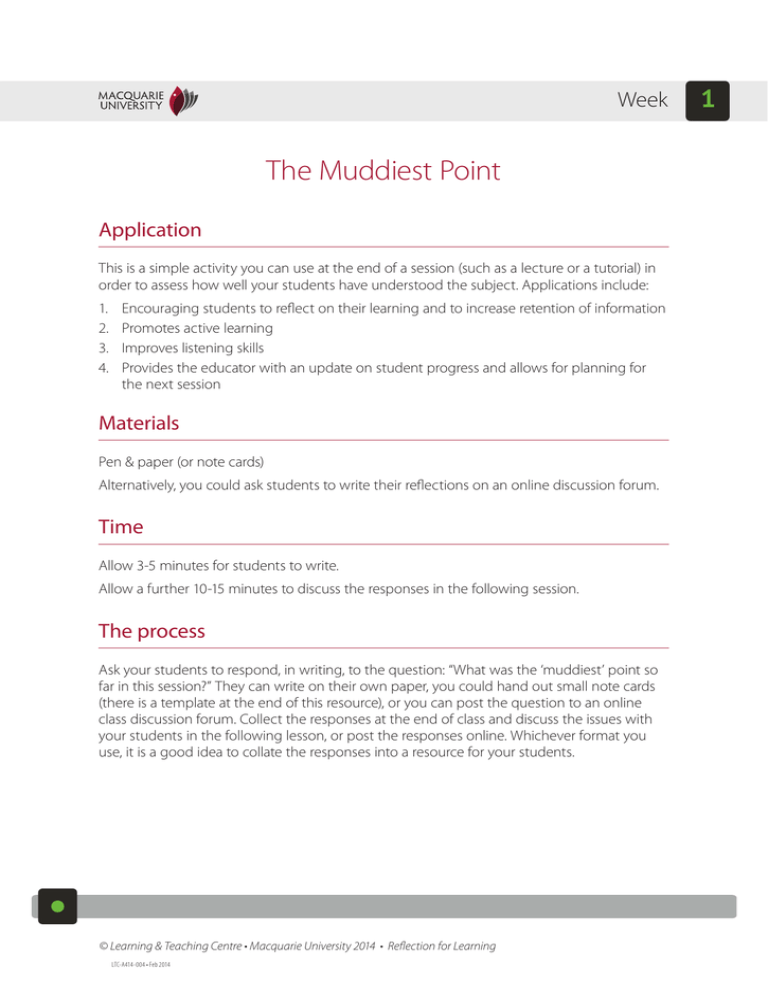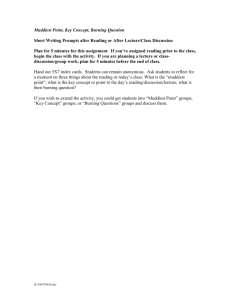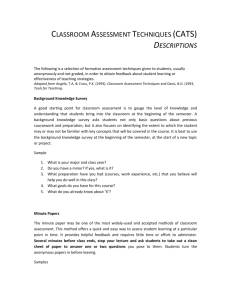The Muddiest Point - Staff
advertisement

Week The Muddiest Point Application This is a simple activity you can use at the end of a session (such as a lecture or a tutorial) in order to assess how well your students have understood the subject. Applications include: 1. 2. 3. 4. Encouraging students to reflect on their learning and to increase retention of information Promotes active learning Improves listening skills Provides the educator with an update on student progress and allows for planning for the next session Materials Pen & paper (or note cards) Alternatively, you could ask students to write their reflections on an online discussion forum. Time Allow 3-5 minutes for students to write. Allow a further 10-15 minutes to discuss the responses in the following session. The process Ask your students to respond, in writing, to the question: “What was the ‘muddiest’ point so far in this session?” They can write on their own paper, you could hand out small note cards (there is a template at the end of this resource), or you can post the question to an online class discussion forum. Collect the responses at the end of class and discuss the issues with your students in the following lesson, or post the responses online. Whichever format you use, it is a good idea to collate the responses into a resource for your students. © Learning & Teaching Centre • Macquarie University 2014 • Reflection for Learning LTC-A414-004 • Feb 2014 1 Week Overview The “Muddiest Point” is a teaching assessment technique developed by Dr. Frederick Mosteller, a Harvard University professor of statistics, in 1989. While it is a handy tool for providing instructors with information on what their students are learning, it is also a useful reflective activity for students. Asking students to reflect on their misconceptions encourages deep conceptual learning (Wandersee, Mintzes and Novak, 1994). Additional research indicates that students can learn to engage in meta-cognitive strategies if they are asked self-assessment questions on a regular basis. By asking students to reflect on their own learning, we encourage them to think deeply and critically (Resnick, 1986). Having said that, the Muddiest Point technique should not be overused, as many students and instructors may find focusing on the negative points discouraging. It is best to use this technique every three to four weeks, and to change the question around so you focus on the most “interesting” or most “surprising” point, for instance (Carlson). References Carlson, A. Centre for Instructional Innovation & Assessment, http://pandora.cii.wwu.edu/cii/resources/modules/muddiestpoint/ Resnick, L. B. (1986). Education and learning to think. Special Report. Pittsburgh: University of Pittsburgh, Commission on Behavioral and Social Sciences and Education. Wandersee, J.H., Mintzes, J.J., & Novak, J.D. (1994). Research on alternative conceptions in science. In D.L. Gabel (Ed.), Handbook of research on science teaching and learning (pp. 177-210). New York: MacMillan. WEEK 1 • The Muddiest Point LTC-A414-004 • Feb 2014 1 TEMPLATE | Week The Muddiest Point Template What was the “muddiest” point so far in this session? In other words, what was least clear to you? © Learning & Teaching Centre • Macquarie University 2014 • Reflection for Learning LTC-A414-004 • Feb 2014 1


